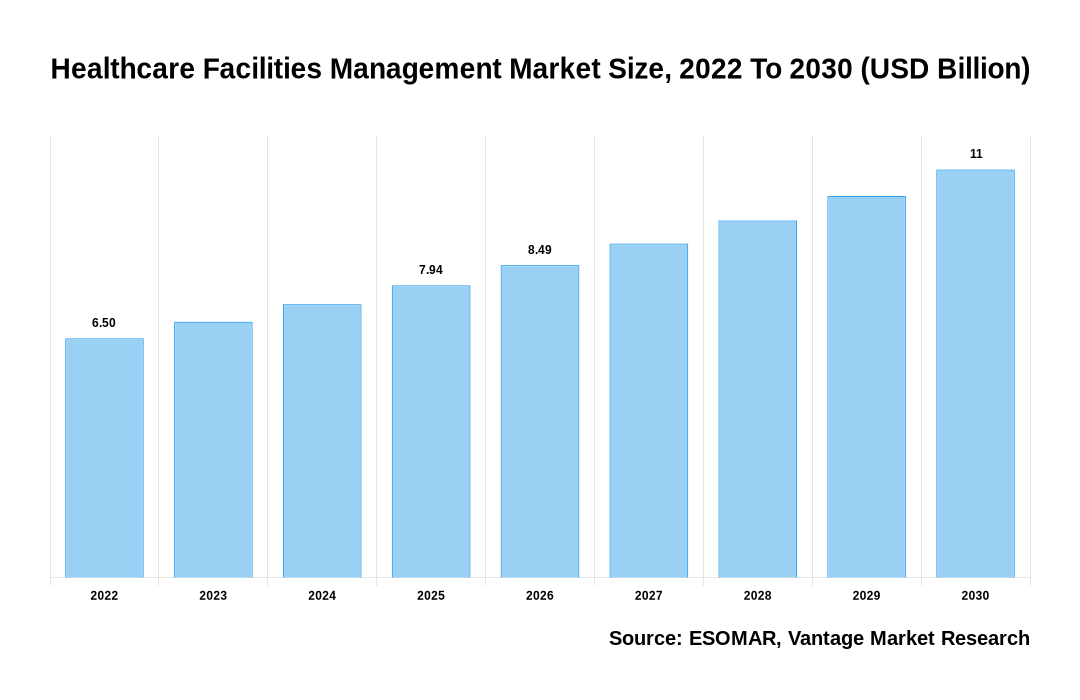Global Healthcare Facilities Management Market
As stated in our extensive report, the Global Healthcare Facilities Management Market accounted for USD 6.5 Billion in 2022 and is projected to reach a value of USD 11 Billion by 2030.
Some numerous factors and drivers drive the growth of the Healthcare Facilities Management market. First, there are now more healthcare facilities, such as hospitals, clinics, and nursing homes, due to the rising demand for high-quality healthcare services. Due to this, these facilities now require effective administration and maintenance, including maintaining sufficient infrastructure, the availability of medical equipment, and regulatory standard compliance. Further, technological advancements have played a significant role in the market’s growth. Adopting digital solutions for asset management, preventive maintenance, and energy optimization has improved Healthcare Facilities Management’s overall efficiency and effectiveness. Furthermore, the rising focus on cost reduction and operational efficiency in healthcare organizations has driven the outsourcing of non-core activities, including facilities management. Outsourcing these services to specialized companies allows healthcare facilities to streamline operations and focus on delivering quality patient care.
Lastly, the increasing emphasis on patient satisfaction and experience has prompted healthcare facilities to invest in modern and well-maintained amenities. This has created a demand for specialized facilities management companies that can provide comprehensive and customized solutions to meet these evolving needs. In conclusion, the drivers responsible for the growth of the Healthcare Facilities Management market include the increasing demand for healthcare services, technological advancements, cost reduction initiatives, and the focus on patient satisfaction and experience.
Click To Get a Free Sample On the Research Study

Factors Influencing Global Healthcare Facilities Management Market Growth
The growth of the global Healthcare Facilities Management market can be attributable to the following:
- The growth of Healthcare Facilities Management is directly linked to the overall healthcare expenditure. As healthcare spending continues to rise globally, healthcare facilities are constantly looking for efficient and cost-effective ways to manage their operations.
- The adoption of advanced technology in Healthcare Facilities Management is a key driver for its growth. Innovations like automated systems, the Internet of Things (IoT), artificial intelligence (AI), and machine learning (ML) are helping to streamline operations, improve patient care, and reduce costs. The implementation of hospital management systems (HMS) enables healthcare facilities to manage various aspects such as patient admissions, bed management, appointment scheduling, and billing. This digital transformation helps improve overall efficiency and patient experience.
- With growing concerns about environmental sustainability, healthcare facilities are increasingly adopting green and energy-efficient practices. Facilities management strategies that focus on reducing energy consumption, waste management, and promoting sustainable operations are gaining importance. Hospitals are investing in energy-efficient lighting, HVAC systems, and water conservation technologies to minimize their carbon footprint. Facilities management companies assist in designing and implementing such initiatives, resulting in long-term cost savings and environmental benefits.
- Governments and private entities are investing significantly in developing and modernizing healthcare infrastructure, especially in emerging markets. This creates opportunities for Healthcare Facilities Management providers to cater to these expanding facilities.
North America Region to Take Over the Market
The largest region in the global Healthcare Facilities Management market is North America. North America has shown significant development in the Healthcare Facilities Management market, with the region witnessing the adoption of advanced technologies and strategies to enhance patient care and optimize facility operations. One example of this development is the implementation of computerized maintenance management systems (CMMS) in healthcare facilities, which streamline maintenance operations and reduce downtime by automating tasks such as asset tracking, preventive maintenance scheduling, and inventory management. Another notable advancement is the integration of data analytics and predictive analytics tools in Healthcare Facilities Management, enabling real-time monitoring of equipment performance, optimization of energy consumption, and proactive maintenance to prevent breakdowns. North America is also witnessing the emergence of mobile applications and cloud-based platforms for facilities management, allowing for remote monitoring and management of critical systems. These developments highlight the region’s commitment to leveraging technology and innovation in Healthcare Facilities Management to improve patient outcomes and operational efficiency.
Conclusion
The Increasing demand for efficient and cost-effective healthcare services has favorably impacted the overall Healthcare Facilities Management market sales. The market has witnessed significant growth, driven by technological advancements, rising healthcare expenditure, and the need for improved patient outcomes. In addition, the COVID-19 pandemic has further emphasized the importance of effective healthcare facility management.
The well-known players of the Global Healthcare Facilities Management Market include 3M Company (U.S.), CBRE Group Inc. (U.S.), Johnson Controls (U.S.), Accruent (U.S.), Jones Lang LaSalle Inc. (U.S.), ABM Industries Inc. (U.S.) and others.
![[Market Research Reports] – Research Google News Blog | VMR.Biz](https://www.vmr.biz/wp-content/uploads/2022/12/logo-removebg-preview.png)











